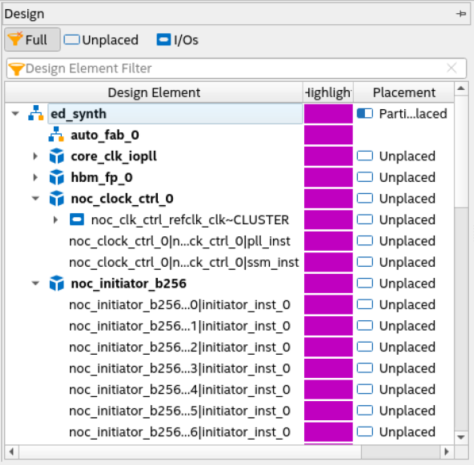Visible to Intel only — GUID: cxr1665161399852
Ixiasoft
Visible to Intel only — GUID: cxr1665161399852
Ixiasoft
3.6. Making NoC Physical Assignments Using Interface Planner
After design synthesis, you can use the Quartus® Prime Interface Planner to help you to make physical assignments to define a legal device floorplan.
Interface Planner allows you to assign physical locations for the periphery elements in your design, such as external memory interfaces or other general purpose I/O. You can also use Interface Planner to assign physical locations for NoC initiators, PLLs, and SSMs. For step-by-step instructions on using Interface Planner, refer to Using Interface Planner.

Interface Planner displays your project's logical hierarchy, post-synthesis design elements, and Fitter-created design elements, alongside a floorplan view of target device locations. The GUI supports a variety of methods for placing design elements in the floorplan. As you place elements in the floorplan, the Fitter verifies legality in real time to ensure accurate correlation with the final implementation.
You can use Interface Planner to assign physical locations for NoC initiators, targets (as part of the HBM2e or external memory interfaces), PLLs, and SSMs. If you do not make physical assignments for NoC elements, the Fitter places NoC elements automatically during compilation. However, the Fitter automatic placement does not optimize for bandwidth utilization.
It is best to place NoC initiators that communicate with AXI4 Lite targets close to the NoC SSM. This placement reduces AXI4 Lite access latency and separates AXI4 Lite and memory traffic on the hard memory NoC.
You use the floorplan view in Interface Planner to place hard memory NoC and periphery elements. There are three floorplan views available:
- NoC View—shows a filtered view of NoC initiators and targets.
- Chip View—shows the placeable locations for hard memory NoC elements, including NoC initiators, targets, PLLs, and SSMs.
- Package View—NoC elements are not visible in the Package View.
In the Chip View, the available NoC initiator and target locations appear as rows of small boxes across the top and bottom edges of the device, between the FPGA fabric and the periphery I/O structures. Placing your cursor over locations displays a tooltip indicating whether the location supports only an initiator, only a target, or both an initiator and a target.
The available NoC PLL and NoC SSM locations appear as smaller boxes at the end of the row of initiators and targets. The PLL and SSM locations appear at the left end of the rows (if using the Chip Top view), or at the right end of the rows (if using the Chip Bottom view). The HPS appears at the top right (if using the Chip Top view) or at the top left (if using the Chip Bottom view).
Figure 46. Interface Planner Chip View, Closeup of NoC Features shows an example of the Interface Planner Chip View showing the top left corner of the die as viewed from the top. The two smaller pink boxes at the top left corner of the fabric are the locations of the NoC PLL and the NoC SSM.
In the NoC View, only the NoC initiators and targets are visible as larger rectangles. The targets and initiators for both high-speed NoC along the top edge of the die, and the high-speed NoC along the bottom edge of the die, are visible. The NoC View splits the initiators and targets that may share the same location in the Chip View. Additionally, the I/O banks and UIBs associated with each group of targets appear for reference. However, you cannot place the memory controllers associated with these targets in the NoC View. Use the Chip View to place these elements.
The outer-top and outer-bottom rows are the targets for the top-edge NoC and bottom-edge NoC, respectively. Similarly, the inner-top and inner-bottom rows are the initiators for the top-edge NoC and bottom-edge NoC, respectively. As with the Chip View, if you place your cursor over one of these locations, a tooltip reports if that location supports a target or an initiator. For the targets, the darker colors represent the main AXI4 targets, while the lighter colors represent the AXI4-Lite targets. The initiators are all the same color, except for one initiator that is white. The white initiator represents the HPS MPFE. These colors are for locations that are not yet assigned. Once you place an initiator or target in one of these locations, the initiator or target changes to a color that you select (default is purple).
Between each set of targets and initiators are four horizontal lines representing the four links that comprise the NoC. Additionally, there are green vertical bars representing the switches that connect the initiators and targets to the horizontal links. The link utilized in going from a particular initiator to a particular target are tabulated in Figure 13. Horizontal Link Allocation for Top-Edge NoC and Figure 14. Horizontal Link Allocation for Bottom-Edge NoC . If you select one of the switches, the NoC View highlights the initiator and any targets that connect using that switch. While the initiators are directly adjacent to the switch they use, the targets may be offset to the left or right. This is particularly true for the targets in the UIB segments, where there are more targets than switches.
Figure 47. NoC View of Targets and Initiators is an example of the Interface Planner NoC View showing the targets and initiators for both the top-edge NoC and the bottom-edge NoC. The row of initiators along the top edge shows 21 rectangles. 20 of these rectangles are for fabric-facing initiators. The last rectangle (shown white) contains the two HPS-facing initiators. Between each row of initiators and targets are horizontal lines representing the NoC links and vertical bars representing the NoC switches. This view is based on the ‘Chip Top’ view.